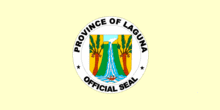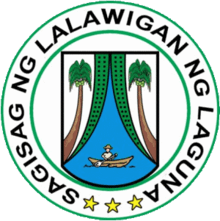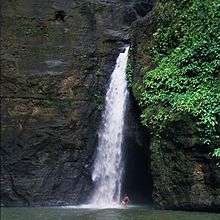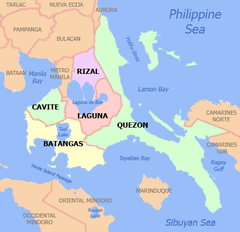Laguna (province)
| Laguna | |||
|---|---|---|---|
| Province | |||
| Lalawigan ng Laguna (Province of Laguna) | |||
|
Laguna Provincial Capitol | |||
| |||
|
Nickname(s):
| |||
| Motto: Rise High, Laguna! | |||
 Location in the Philippines | |||
| Coordinates: 14°10′N 121°20′E / 14.17°N 121.33°ECoordinates: 14°10′N 121°20′E / 14.17°N 121.33°E | |||
| Country | Philippines | ||
| Region | Calabarzon (Region IV-A) | ||
| Founded | July 28, 1571[3][4] | ||
| Capital | Santa Cruz | ||
| Government | |||
| • Type | Sangguniang Panlalawigan | ||
| • Governor | Ramil L. Hernandez (Nacionalista) | ||
| • Vice Governor | Katherine Agapay (Nacionalista) | ||
| Area[5] | |||
| • Total | 1,917.85 km2 (740.49 sq mi) | ||
| Area rank | 63rd out of 81 | ||
| Population (2015 census)[6] | |||
| • Total | 3,035,081 | ||
| • Rank | 3rd out of 81 | ||
| • Density | 1,600/km2 (4,100/sq mi) | ||
| • Density rank | 3rd out of 81 | ||
| Divisions | |||
| • Independent cities | 0 | ||
| • Component cities | |||
| • Municipalities | |||
| • Barangays | 681 | ||
| • Districts | 1st to 5th districts of Laguna | ||
| Demographics | |||
| • Ethnic groups | |||
| Time zone | PHT (UTC+8) | ||
| ZIP Code | 4000–4033 | ||
| IDD : area code | +63 (0)49 | ||
| ISO 3166 code | PH-LAG | ||
| Spoken languages | |||
| Website |
www | ||
Laguna, officially known as the Province of Laguna (Filipino: Lalawigan ng Laguna ; Spanish: Provincia de La Laguna), is a province in the Philippines located in the Calabarzon region in Luzon. Its capital is Santa Cruz and the province is situated southeast of Metro Manila, south of the province of Rizal, west of Quezon, north of Batangas and east of Cavite. Laguna hugs the southern shores of Laguna de Bay, the largest lake in the country. As of the 2015 census, the province's total population is 3,035,081.[6]
Laguna is notable as the birthplace of Jose Rizal, the country's national hero. It is also famous for attractions like Pagsanjan Falls, the University of the Philippines Los Baños campus, the hot spring resorts of Los Baños and Calamba on the slopes of Mount Makiling, Pila historic town plaza, Taytay Falls in Majayjay, the wood carvings and papier-mâché created by the people of Paeté, the annual Sampaguita Festival in San Pedro, the turumba of Pakil, the tsinelas footwears from Liliw, the Pandan Festival of Luisiana, the Seven Lakes of San Pablo (the first city in the province), and the Nagcarlan Underground Cemetery in Nagcarlan
Province of Laguna is the second ISO 9001:2008 certified province in the Philippines.[7]
History
The Province of Laguna, which was formerly called La Laguna and La Provincia de la Laguna de Bay, was named after Laguna de Bay, the body of water that forms its northern boundary.[8] Laguna de Bay, in turn, was named after the town of Bay (Laguna de Bay is Spanish which means "Lake of Bay"), the first provincial capital. Captain Juan de Salcedo with a band of one hundred Spanish-Mexican soldiers conquered the province and its surrounding regions for Spain in 1571. Seven years later, two Franciscan friars started the work of Christianization.

In 1577, the Franciscan missionaries arrived in Manila, and in 1578 they started evangelizing Laguna, Morong (now Rizal), Tayabas (now Quezon) and the Bicol Peninsula. Juan de Plasencia and Diego de Oropesa were the earliest Franciscans sent to these places. From 1580, the towns of Bay, Caliraya, Majayjay, Nagcarlan, Liliw, Pila, Santa Cruz, Lumban, Pangil and Siniloan were founded. In 1678, Fray Hernando Cabrera founded San Pablo de los Montes (now San Pablo City) and built a wooden church and convent considered as the best and finest in the province.[9]
In 1670, delimitation of borders were made between Lucban, Majayjay and Cavite. The populous town at that time was Bay, the capital of the province until 1688, when the seat of the provincial government was moved to Pagsanján, and later in 1858, to Santa Cruz. In 1754, the Province of Laguna and Tayabas were divided, with the Malinao River separating the towns of Majayjay and Lucban.[9]
The province became a bloody battle ground for the Chinese during the two instances that they rose in revolt against Spain.[8] In 1603, the Chinese made their last stand in the mountains of San Pablo, and in 1639, they fortified themselves in the highlands of Cavinti and Lumban, surrendering in Pagsanjan a year later.
The natives of Laguna proved loyal to the Spanish crown during the British invasion (1762–1764) when thousands rallied to its defense. When a detachment of British troops under Captain Thomas Backhouse entered the province in search of the silver cargo of the galleon Filipino, Francisco de San Juan of Pagsanján led a band of volunteers that fought them in several engagements in and around the town which was then the provincial capital (1688–1858). Backhouse plundered the town and burned its newly reconstructed church but San Juan succeeded in escaping with the precious hoard to Pampanga where the treasure greatly bolstered the defense effort of Simón de Anda, leader of the resistance movement. For his heroism, San Juan was made a brigade commander and alcalde mayor of Tayabas (now Quezon) province.[9]
The people's loyalty gradually degenerated into bitter hostility. Grave abuses by the colonizers, especially those of the clergy, caused the resentment of the natives to be fanned into a rising flood of insurrection. In 1840 for instance, religious intolerance led the people of Majayjay, Nagcarlan, Bay, and Biñan to join the revolt of Hermano Pule (Apolinario de la Cruz) of Lucban, Tayabas.[9]
Laguna was also exposed to the aspirations of its most famous son, Dr. José Rizal, who was born in Calamba. The persecution of the Rizal family, along with their fellow landowners toward the end of the century further aggravated the situation. In 1896, thousands of inhabitants, especially of Bay, Los Baños, Nagcarlan, Magdalena, Santa Cruz, and Pagsanjan had joined the revolutionary Katipunan.[9]
Laguna was one of the eight provinces to rise in revolt against the Spanish misrule led by Generals Paciano Rizal of Calamba, Severino Taino of Pagsanjan, Agueda Kahabagan of Calauan, and Miguel Malvar of Batangas.[8] The ill-equipped revolutionaries fought the well-armed enemy until on August 31, 1898, when the last Spanish garrison surrendered to the victorious patriots in Santa Cruz. The province was cleared of Spaniards. There had been only one respite, the Pact of Biak-na-Bato on December 14 to 15, 1897.[9]
Laguna actively supported the First Philippine Republic proclaimed at Malolos on January 23, 1899. Its two delegates to the Malolos Congress were Don Higino Benítez and Don Graciano Cordero, both natives of Pagsanján.[9]
Upon the outbreak of the Filipino-American War (1899–1901), Generals Juan Cailles and Paciano Rizal led the defense of Laguna until June 30, 1901, when surrender became inevitable. Cailles became the first Filipino Governor of Laguna under the American flag.
Laguna was also the birthplace of a famous revolutionary hero Teodoro Asedillo during the American colonization period. He was considered as bandit during those times by the Americans but hailed as hero by the local town folks of Laguna. He fought for labor and civil rights of the Filipino people.
The Province of Laguna progressed rapidly in peace. Roads were built, schools were established, and in 1917, the Manila Railroad Company extended its line to Laguna as far as Pagsanjan.
During the Japanese occupation of the Philippines (1942–1945), Laguna was a center of Filipino resistance despite the presence of Makapili collaborators.[9]
The establishment of the military general headquarters and military camp bases of the Philippine Commonwealth Army and the Philippine Constabulary is a military unit organization was founded on January 3, 1942 to June 30, 1946 in the province of Laguna, and aided of the local military regular units of the Philippine Commonwealth Army 4th and 42nd Infantry Division and the Philippine Constabulary 4th Infantry Regiment. Started the engagements of the Anti-Japanese Military Operations in Southern Luzon, Mindoro and Palawan from 1942 to 1945 against the Japanese Imperial forces.
Beginning in 1945, attacks by the Filipino soldiers of the 4th, 41st, 42nd, 43rd, 45th, 46th and 47th Infantry Division of the Philippine Commonwealth Army, 4th Infantry Regiment of the Philippine Constabulary and the recognized guerrillas against Japanese forces in Laguna increased in anticipation of the Liberation of the Philippines by joint Filipino & American forces.
Geography
Laguna covers a total area of 1,917.85 square kilometres (740.49 sq mi)[10] occupying the north‑central section of the CALABARZON region in Luzon. The province is situated southeast of Metro Manila, south of Rizal, west of Quezon, north of Batangas and east of Cavite.
Laguna lies on the southern shores of Laguna de Bay, the largest lake in the country. On the southern border of the province are Mount Makiling and Mount Banahaw, both are long dormant volcanoes, but still sources of geothermal energy. Mount Makiling is popular for the numerous hot spring resorts that are found on its slopes. Pagsanjan Falls, is a popular waterfall that tumbles down a deep gorge in the hills.
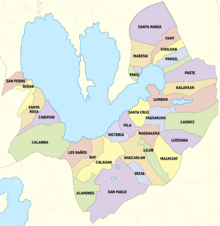
The eastern portion of Laguna straddles the southernmost portions of the Sierra Madre mountain range.
Climate
The province is relatively dry from November to April and wet during the rest of the year for a small portion near the southern boundary. The other parts, west of Santa Cruz municipality, experience a dry season from November to April and rainy season during the rest of the year. The eastern and southern most portions do not have distinct season, with rainfall more evenly distributed throughout the year.
Administrative divisions
Laguna comprises 24 municipalities and 6 cities.
- † Capital municipality
- ∗ Component city
- Municipality
| |||||||||||||||||||||||||||||||||||||||||||||||||||||||||||||||||||||||||||||||||||||||||||||||||||||||||||||||||||||||||||||||||||||||||||||||||||||||||||||||||||||||||||||||||||||||||||||||||||||||||||||||||||||||||||||||||||||||||||||||||||||||||||||||||||||||||||||||||||||||||||||||||||||||||||||||||||||||||||||||||||||||||||||||||||||||||||||||||||||||||||||||||||||||||||||||||||||||||||||||||||||||||||||||||||||||||||||||||||
Districts

As of 2015, Laguna is composed of 5 districts.
| 1st District (Red) | 2nd District (Blue) | 3rd District (Green) | 4th District (Orange) |
|---|---|---|---|
| San Pedro City | Calamba City | ||
| Santa Rosa City | Cabuyao City | ||
| Los Baños | |||
| Bay |
Demographics
| Population census of Laguna | |||||||||||||||||||||||||||||||||||||||||||||||||
|---|---|---|---|---|---|---|---|---|---|---|---|---|---|---|---|---|---|---|---|---|---|---|---|---|---|---|---|---|---|---|---|---|---|---|---|---|---|---|---|---|---|---|---|---|---|---|---|---|---|
|
| ||||||||||||||||||||||||||||||||||||||||||||||||
| Sources: National Statistics Office[6][11][15] | |||||||||||||||||||||||||||||||||||||||||||||||||
The population of Laguna in the 2015 census was 3,035,081 people,[6] with a density of 1,600 inhabitants per square kilometre or 4,100 inhabitants per square mile.
Religion
Most of Laguna people are Roman Catholic followed by a large majority of the population at 70% (San Pablo (Diocese) [Catholic-Hierarchy], 2010). Several Christian groups are also present such as Aglipayan Church with 20% of the population and the rest are Members Church of God International, Baptists, Jesus Is Lord Church, Iglesia Ni Cristo, Methodists, Church of Christ of Latter-Day Saints, Jehovah's Witnesses, Presbyterians, Seventh-day Adventist and other Mainline Protestants. Non Christians are usually Muslims.
Economy
Present-day Laguna shows a thriving economy. With a population of 3,035,081 (2015 census),[6] and a total area of 1,760 km2 (680 sq mi) of land, Laguna produces millions of pesos worth of coconuts, rice, sugar, citrus fruits, lanzones and other products. Tourists flock to its beauty spots, especially Pagsanjan Falls, Calamba and Los Baños hot springs, Mount Makiling, Caliraya Lake and many others. Levels of development vary. The towns near Metro Manila have become industrialized whereas the inner towns continue to engage in agricultural production or pursue agri-based industries and cottage and small-scale industries.[9]
Natural resources
Laguna is located in the foothills of three mountains namely, Mount Makiling, Mount Banahaw, and the Sierra Madre Range.
There are about forty rivers in Laguna with a total area of almost 0.5 square kilometres (0.19 sq mi). The Laguna de Bay has an approximate area of 3,800 square kilometres (1,500 sq mi) broken down into 2,900 square kilometres (1,100 sq mi) of land and 900 square kilometres (350 sq mi) of lake proper with 220 kilometres (140 mi) shoreline.
Laguna has an estimated 300 million US gallons (1,100,000 m³) of underground water. At least seven principal water basins in the province with a total of 5,773 square kilometres (2,229 sq mi) drainage area and 1,316 square kilometres (508 sq mi) level area provide an estimated 9.238 square kilometres (3.567 sq mi) total run-off annually.[2]
Agricultural activities
Laguna has 60,624 hectares (149,810 acres) of alienable and disposable agricultural land. About 41,253 hectares (101,940 acres) or 23.44% of Laguna’s total land area is forest land.
Laguna de Bay, with a surface area of 900 kilometres (560 mi), is the province's main fishing ground producing 410,000 mt(?) of fish. Carp and tilapia fingerlings are also being grown in inland ponds and freshwater fish pens. The research institutions located in Los Baños are: International Rice Research Institute (IRRI), ASEAN Center for Biodiversity (ACB) and the Southeast Asian Regional center for Graduate Study and Research in Agriculture (SEARCA), among others.[2]
Infrastructure
Laguna is labeled as the Detroit of the Philippines because of the presence of major vehicle manufacturers in the city of Santa Rosa. It is also considered as the Silicon Valley of the Philippines because of the vast number of electronic and semi-conductor companies operating in the province. Laguna is also the Resort Capital of the Philippines for it houses more than 700 hot spring resorts in the areas of Calamba and Los Baños.[1][2]
Road network
The South Luzon Expressway (SLEx) passes through Laguna. A public-private partnership initiative of the national government include plans to build a circumferential road along Laguna de Bay shoreline, the Laguna de Bay Flood Control Dike Expressway (or C-6 Extension),[16] from San Pedro to Siniloan. Some of the proposed road networks is the Calamba-Los Baños Expressway[2][17] and the Cavite–Laguna Expressway that will connect the provinces of Cavite and Laguna.
Power
Three power generating plants are operating in the province.[2]
- Botocan Hydro-electric Plant (25MW) — Majayjay
- Caliraya Hydro-electric Plant (23.5 MW) — Kalayaan
- Mak-Ban Geothermal Plant (20MW) — Bay
Meralco, the main electricity distributor of Metro Manila, has also the franchise for most of Laguna.[2]
Government
Elected Officials:
- Governor Ramil L. Hernandez (Nacionalista)
- Vice-Governor: Katherine Agapay (Nacionalista)
Board Members:
|
|
House of Representatives
- 1st District: Arlene B. Arcillas (Liberal)
- 2nd District: Joaquin Chipeco Jr. (Liberal)
- 3rd District: Sol Aragones-Sampelo (UNA)
- 4th District: Benjamin Aragao (Liberal)
- Lone District of Biñan City: Marlyn Alonte-Naguiat (Liberal)
On May 21, 2014, the COMELEC En Banc unseats E.R. Ejercito in a unanimous decision for overspending of campaign funds for his running for the 2013 Laguna gubernatorial elections, Vice Governor Ramil Hernandez will take over the position of Ejercito.[18] And on May 27, 2014, Vice Governor Ramil Hernandez took oath and became the acting governor of the province, making Ejercito the first local official in the Philippines to be formally ousted in office due to overspending.
Tourism
Historical
|
Underground Cemetery |
Natural
|
|
Man-made
|
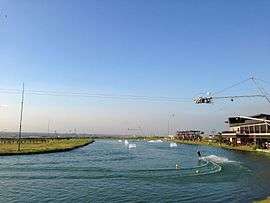 Nuvali Calamba Republic Wakepark |
Education
Universities
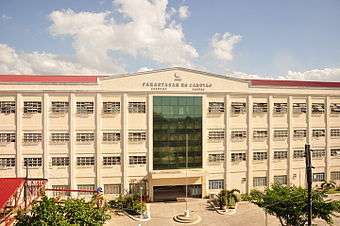
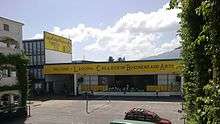
- De La Salle University — Science and Technology Complex
- Laguna State Polytechnic University
- Laguna University
- Laguna University - Main Campus (Bay)
- Laguna University - Santa Cruz Campus
- Lyceum of the Philippines University – Laguna
- Pamantasan ng Cabuyao
- Philippine Women's University - Calamba
- Polytechnic University of the Philippines
- University of Perpetual Help System
- University of the Philippines Los Baños
- University of the Philippines Open University
- University of Santo Tomas - Santa Rosa
Colleges
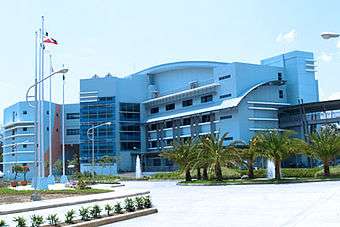
- ACTS Computer College-Sta. Cruz
- Balian Community College - Pangil
- Calamba Doctors' College
- Canossa College- San Pablo City
- Casa Del Niño Schools System
- City College of Calamba
- Colegio de Los Baños
- Colegio de San Juan de Letran - Calamba
- Colegio de Santo Niño de Cabuyao
- Colegio San Agustin – Biñan
- Colegio De San Pedro
- Dalubhasaan ng Lungsod ng San Pablo
- Deaf Evangelistic Alliance Foundation – Cavinti
- Dominican College in Sta. Rosa
- La Consolacion College - Biñan
- Laguna College
- Laguna College of Business and Arts
- Laguna Northwestern College- San Pedro, Sta.Rosa, Siniloan
- Malayan Colleges Laguna
- Mary Help of Christian College in Canlubang, Calamba City
- Miriam College Nuvali
- Our Lady of Assumption College
- Paete Science & Business College, Inc., Paete, Laguna
- Rizal College of Laguna
- Saint Francis Institute of Computer Studies, San Pedro City
- Saint John Colleges in Calamba City
- Saint Mary's Academy of Nagcarlan
- Saint Michael's College of Laguna
- Saint Vincent College of Cabuyao
- San Antonio de Padua College - Pila
- Saint Louis Anne Colleges San Pedro, Laguna
- San Pablo Colleges
- San Pedro College of Business Administration
- San Sebastian College – Recoletos
- Union College of Laguna
- Xavier School Nuvali
Arts and culture
Laguna is a major contributor to the development of arts in the Philippines. Paintings and sculptures from Paete, which is the Woodcarving Capital of the Philippines, won national and international awards. Famous artists include Manuel Baldemor, Fred Baldemor, Felix "Kid" Baldemor and Dominic Rubio.
| Church Paintings in Paete | ||
Church Mural |
Church Mural |
Church Mural |
Notable people
- José Rizal, national hero of the Philippines
- Paciano Rizal, military general and revolutionary; older brother of José Rizal
- Vicente Lim, World War II general
- Saturnina Rizal Hidalgo, José Rizal's eldest sister
- Pedro Guevara, soldier, lawyer, and legislator
- Francisco Benitez, First Dean of UP College of Education, educator, author, from Pagsanjan
- Crispin Oben, lawyer, member of the First Philippine Assembly
- Ambrosio Rianzares Bautista, lawyer and author of the Declaration of Philippine Independence
- Pedro Pelaez, educator, priest, "Father of Filipinization of the Church" from Pagsanjan
- Juan Cailles, governor of Laguna from 1901 to 1910, and again from 1916 to 1925, reelected in 1934
- Estanislao Fernandez, lawyer, former Associate Justice of the Supreme Court of the Philippines
- Gregorio F. Zaide, "Dean of Filipino Historiographers", historian, author from Pagsanjan
- Loren Legarda, senator
- Phoemela Baranda, model, actress, and entertainment anchor from Majayjay, Laguna
- Charice Pempengco, well-known international pop star
- E. R. Ejercito, actor and incumbent governor of Laguna from Pagsanjan
- Danilo Fernandez, actor, doctor, and politician (Laguna First District representative)
- Sol Aragones, former TV/radio host and reporter, 3rd District Representative, (Laguna Third District representative)
- Jun Hemedes, Jr., city mayor of Cabuyao
- Arlene B. Arcillas, city mayor of Santa Rosa
- Vicente B. Amante, city mayor of San Pablo
- Calixto Cataquiz, former city mayor of San Pedro
- Teresita S. Lazaro, former governor of Laguna
- Jose Catindig, Jr., former mayor of Santa Rosa
- Antonio Sanchez, former mayor of Calauan
- Joey Lina, former senator and former governor of Laguna
- Dominador Chipeco, Jr., lawyer, former vice presidential candidate
- Ernesto Maceda, former councilor of Manila, former senator, columnist and lawyer from Pagsanjan
- Cielito Habito, economist, professor, former NEDA Director-General
- Alfredo E. Evangelista, archaeologist
- Ariella Arida, Miss Universe-Philippines 2013 and Miss Universe 2013 3rd Runner-up
- Erik Spoelstra, head coach of Miami Heat
- Jojo Acuin, psychic
- Angeli Gonzales, actress
- Bayani Casimiro, tap dancer
- Alfie Anido, actor, matinee idol
- Flor Contemplacion, domestic worker
- Ronato Alcano, professional pool player
- Rico Blanco, singer, songwriter
- Julia Clarete, host, singer, actress
- Mario Montenegro, actor from Pagsanjan
- Paw Diaz, actress, model, TV host
- Danica Gabriel, TV host, radio commentator, politician
- Dion Ignacio, actor
- Louie Ignacio, TV director from Pagsanjan
- Angelica Jones, TV host, singer, actress, Board Member (3rd District)
- C. J. Muere, actor
- Didith Reyes, actress, singer
- John Lloyd Cruz, actor
- Sabrina Man, child actress
- Alden Richards, model, actor, half of AlDub love team
- Sabrina, singer
- Nadine Samonte, actress
- Princess Snell, actress
- Halina Perez, model, actress
- Carmina Villaroel, actress
- Charo Ronquillo, fashion model
- Juvy Cachola, actress
- Led Sobrepeña III, singer of The Singing Bee, Singer, Actor, Comedian
- Charlene Almarvez, fashion model
- Jedah Hernandez, beauty pageant titleholder
- Celia Rodriguez, Filipino
- Barbie Forteza, actress, model
- Joan Da, Finalist of the X Factor Philippines
- Thea Tolentino, female winner of GMA Network's Protégé Season 2
- Jeric Gonzales, male winner of GMA Network's Protégé Season 2
- Stephanie Retuya, contestant and runner-up in Asia's Next Top Model (cycle 1)
- HaveYouSeenThisGirl, author of the books Diary ng Panget, Voiceless and She Died who came from San Pablo City, Laguna.
- Rence Rapanot, singer
- Mackie Cao, singer
- Jason Fernandez, singer, former vocalist of Rivermaya
See also
- Campaigns of the Philippine–American War
- Laguna Lake Development Authority
- Roman Catholic Diocese of San Pablo
- Legislative districts of Laguna
References
- 1 2 "Laguna, pangunahing lugar na puntahan, tirahan, at pangalakalan". Philippine Information Agency.
- 1 2 3 4 5 6 7 "Province Profile". Provincial Government of Laguna.
- ↑ "28 JULY 1571: The Foundation date of the Province of Laguna". Academia.edu.
- ↑ Young historian finds Laguna birth date|Inquirer News
- ↑ "List of Provinces". PSGC Interactive. Makati City, Philippines: National Statistical Coordination Board. Retrieved 18 November 2013.
- 1 2 3 4 5 6 Census of Population (2015): Highlights of the Philippine Population 2015 Census of Population (Report). PSA. Retrieved 20 June 2016.
- ↑ PGL now ISO 9001:2008 certified
- 1 2 3 "History of Laguna". Calirayalake.com. Retrieved 23 June 2016.
- 1 2 3 4 5 6 7 8 9 History - Laguna, Philippines
- 1 2 3 "Province: Laguna (province)". PSGC Interactive. Quezon City, Philippines: Philippine Statistics Authority. Retrieved 8 January 2016.
- 1 2 Census of Population and Housing (2010): Population and Annual Growth Rates for The Philippines and Its Regions, Provinces, and Highly Urbanized Cities (PDF) (Report). NSO. Retrieved 29 June 2016.
- ↑ Congress of the Philippines (March 27, 2015). "Republic Act No. 10658". Retrieved June 13, 2016.
- ↑ COMELEC (August 18, 2015). "Resolution No. 9982 - Annex B" (PDF). Retrieved June 13, 2016.
- ↑ "Los Baños". Laguna Travel Guide. 2000-09-17. Retrieved 2012-10-29.
- ↑ "Region IV-A (CALABARZON)". Census of Population and Housing (2010): Total Population by Province, City, Municipality and Barangay (Report). NSO. Retrieved 29 June 2016.
- ↑ dpwh.gov.ph "Private-Public Partnership - Laguna de Bay Flood Control Dike Expressway (C-6 Extension)"
- ↑ dpwh.gov.ph "Private-Public Partnership - Calamba-Los Baños Expressway"
- ↑ Comelec unseats ER Ejercito for overspending
External links
-
 Media related to Laguna (province) at Wikimedia Commons
Media related to Laguna (province) at Wikimedia Commons -
 Geographic data related to Laguna (province) at OpenStreetMap
Geographic data related to Laguna (province) at OpenStreetMap - Official Website of the Province of Laguna
- Laguna Travel Guide - Tourism Philippines
- Philippine Standard Geographic Code
- 2010 CALABARZON Census Information
- Local Governance Performance Management System
- Visit Laguna - Tourist Spot in Laguna, Things to do in Laguna
 |
Metro Manila | Rizal Laguna de Bay |
 | |
| Cavite | |
Quezon | ||
| ||||
| | ||||
| Batangas | Quezon |
